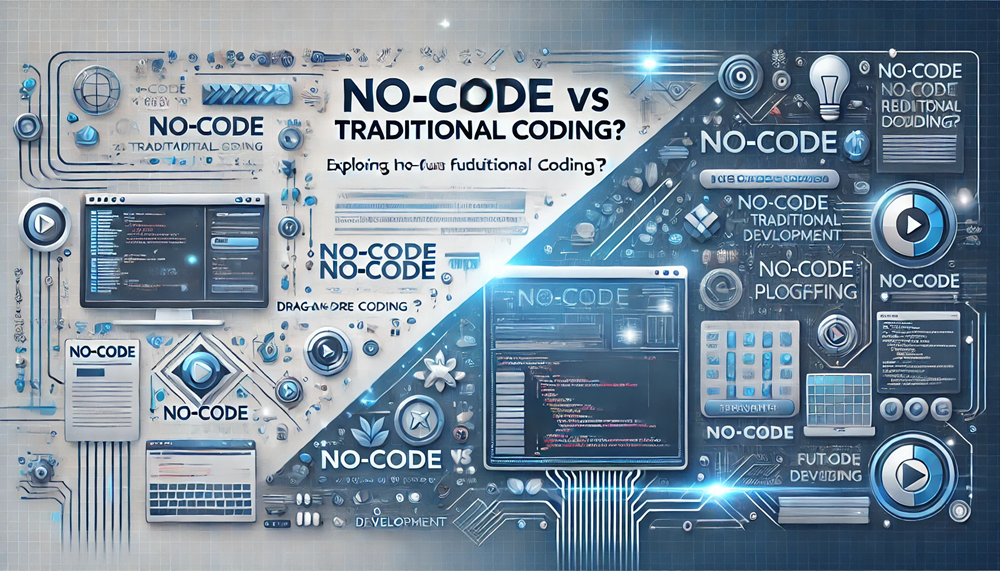Introduction: The Rise of No-Code Development
The world of software development is undergoing a transformation, with No-Code platforms emerging as powerful alternatives to traditional coding. No-Code tools allow individuals to build websites, mobile apps, automation workflows, and even AI-driven applications—without writing a single line of code.
But as No-Code platforms evolve, a pressing question arises: Can No-Code replace traditional coding? Will developers become obsolete, or will No-Code simply be another tool in the programmer’s arsenal?
In this article, we’ll explore the capabilities, limitations, and future of No-Code development, comparing it to traditional programming to understand where it fits in today’s tech landscape.
What is No-Code Development?
No-Code development refers to visual programming platforms that enable users to build software applications through drag-and-drop interfaces, pre-built components, and automated logic workflows—without writing code manually.
Key Features of No-Code Platforms:
✔ Drag-and-drop interface for building applications
✔ Pre-built integrations for databases, APIs, and third-party tools
✔ Automated workflows for app functionality
✔ One-click deployment to web and mobile platforms
Popular No-Code platforms like Bubble, Webflow, Adalo, and Zapier are empowering non-technical founders, startups, and enterprises to build software faster and more affordably than traditional development.
How No-Code is Transforming Software Development
No-Code platforms have opened new possibilities for businesses and entrepreneurs by making software accessible to everyone, not just developers. Here’s how No-Code is changing the game:
1. No-Code Speeds Up Development Time
✔ Traditional software development takes weeks or months, while No-Code allows MVPs (Minimum Viable Products) to be built in days or hours.
✔ No-Code eliminates manual coding for UI design, databases, and workflows, drastically reducing development time.
🚀 Example: Startups can now launch fully functional prototypes within days using platforms like Bubble or Adalo, instead of hiring expensive developers.
2. No-Code Reduces Costs for Businesses & Startups
✔ Hiring developers is expensive—No-Code eliminates the need for full-stack engineering teams.
✔ Businesses can cut development costs by up to 70% by using No-Code for building apps, websites, and automation workflows.
🚀 Example: A small business that needed a mobile app for customers used Thunkable to create an MVP, avoiding the $50,000+ cost of hiring developers.
3. No-Code Expands Who Can Build Software
✔ No-Code tools allow entrepreneurs, marketers, designers, and business owners to build apps without technical expertise.
✔ It democratizes software development, enabling more innovation across industries.
🚀 Example: A non-technical entrepreneur built an entire SaaS product using Bubble without writing a single line of code.
Can No-Code Completely Replace Traditional Coding?
While No-Code is incredibly powerful, it still has limitations. Here’s why traditional coding won’t be replaced anytime soon:
1. No-Code Has Customization Limits
✔ No-Code platforms offer pre-built templates and components, but advanced features still require custom code.
✔ For highly complex applications, No-Code may not provide the required flexibility.
🚀 Example: A startup using Bubble may eventually need to hire developers to customize database interactions and optimize performance.
2. No-Code is Not Ideal for Large-Scale Systems
✔ Enterprise-grade software handling millions of users requires scalable architectures that No-Code platforms may not support.
✔ No-Code solutions are best for MVPs, internal tools, and lightweight apps, but not for high-performance systems like Netflix or Uber.
🚀 Example: Large-scale financial platforms still rely on custom-coded solutions for security, speed, and data processing.
3. No-Code Relies on Platform Providers
✔ No-Code platforms are controlled by third-party providers, meaning startups must operate within their limitations.
✔ If a No-Code platform shuts down, businesses may lose their applications unless they migrate to a new system.
🚀 Example: A business built entirely on Glide (a Google Sheets-based No-Code tool) may struggle if Google changes its API policies.
What Types of Apps Can Be Built with No-Code?
No-Code is powerful enough to build a variety of applications, including:
1. Web Apps & SaaS Platforms
🔹 Tools: Bubble, Softr, Webflow
🔹 Example: Building a marketplace, CRM, or project management tool
2. Mobile Apps
🔹 Tools: Adalo, Thunkable
🔹 Example: Launching an iOS or Android app without coding
3. Automation & Workflow Management
🔹 Tools: Zapier, Make (formerly Integromat)
🔹 Example: Automating email marketing, lead generation, and data processing
4. E-Commerce Stores
🔹 Tools: Shopify, Webflow, Carrd
🔹 Example: Creating an online store with automated checkout and inventory management
Will Developers Still Be Needed in the Future?
Absolutely! No-Code is a tool, not a replacement for developers. In fact, developers can use No-Code platforms to speed up software development.
Why Developers Will Still Be Important:
✔ No-Code needs custom integrations and performance optimizations
✔ Companies still require full control over complex applications
✔ No-Code accelerates development but doesn’t replace software engineering expertise
🚀 Example: Many tech companies are hiring “No-Code developers”—experts who blend No-Code tools with traditional coding for optimal results.
No-Code vs. Low-Code vs. Traditional Coding: What’s the Difference?
| Development Type | Best For | Customization | Skill Requirement |
|---|---|---|---|
| No-Code | Startups, small businesses, MVPs | Limited | No technical skills needed |
| Low-Code | Enterprises, mid-level apps | Moderate | Some coding required |
| Traditional Coding | Complex, large-scale systems | High | Requires full programming skills |
Final Verdict: Can No-Code Replace Traditional Coding?
✔ No-Code is a revolutionary tool, but it won’t fully replace traditional coding.
✔ For simple apps, websites, and automations, No-Code is the fastest and most cost-effective choice.
✔ For complex applications, traditional coding remains essential.
Instead of replacing developers, No-Code is making software development more accessible to everyone—empowering entrepreneurs, business owners, and creatives to turn ideas into reality without technical barriers.
